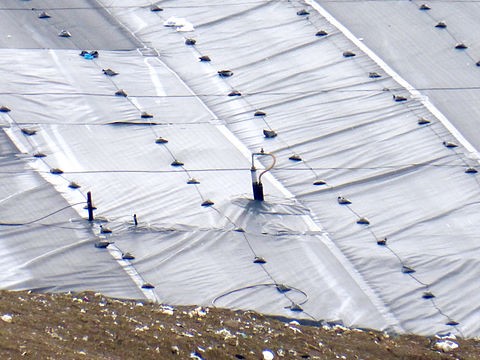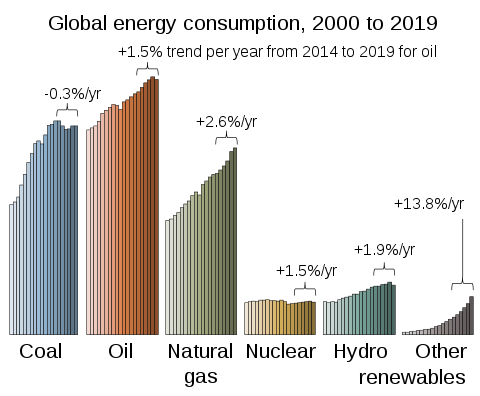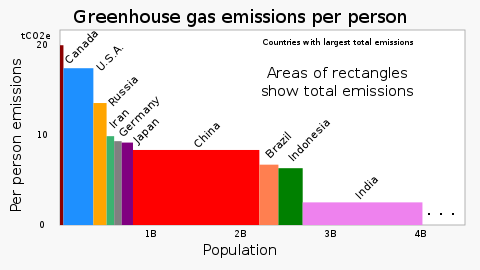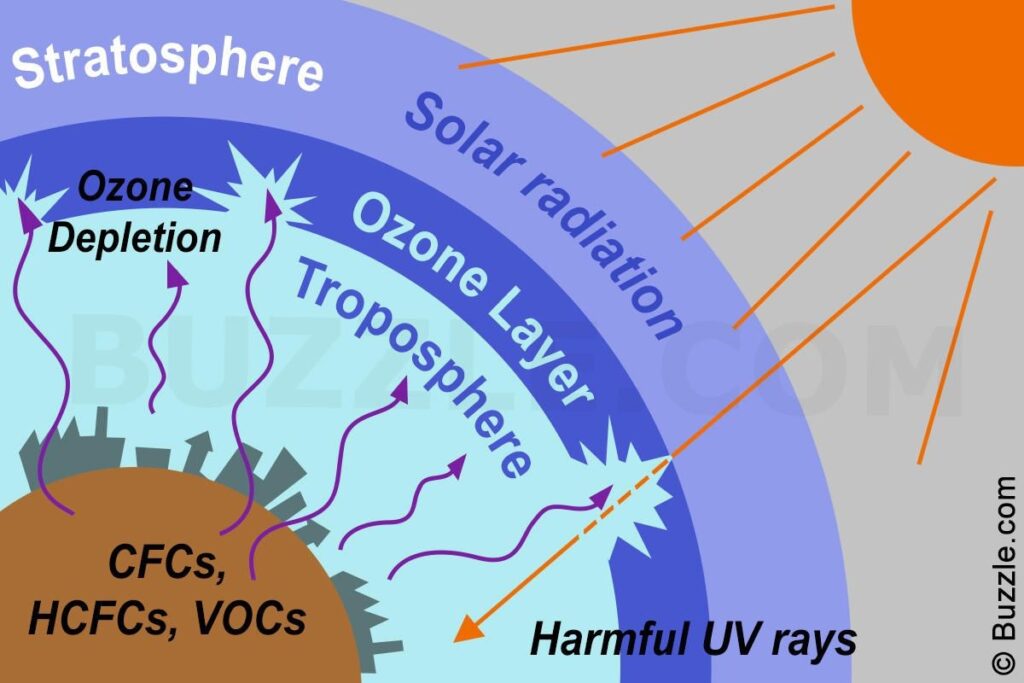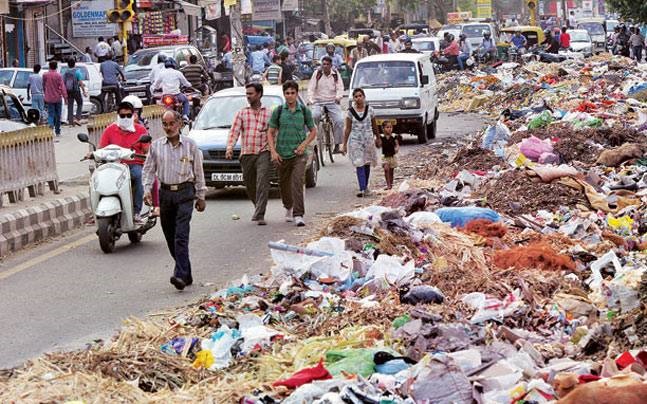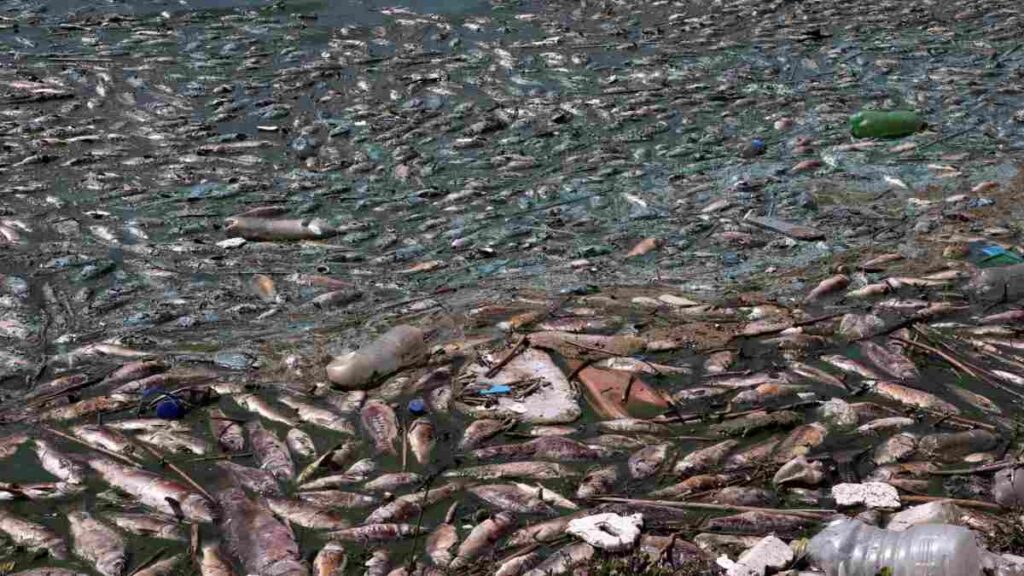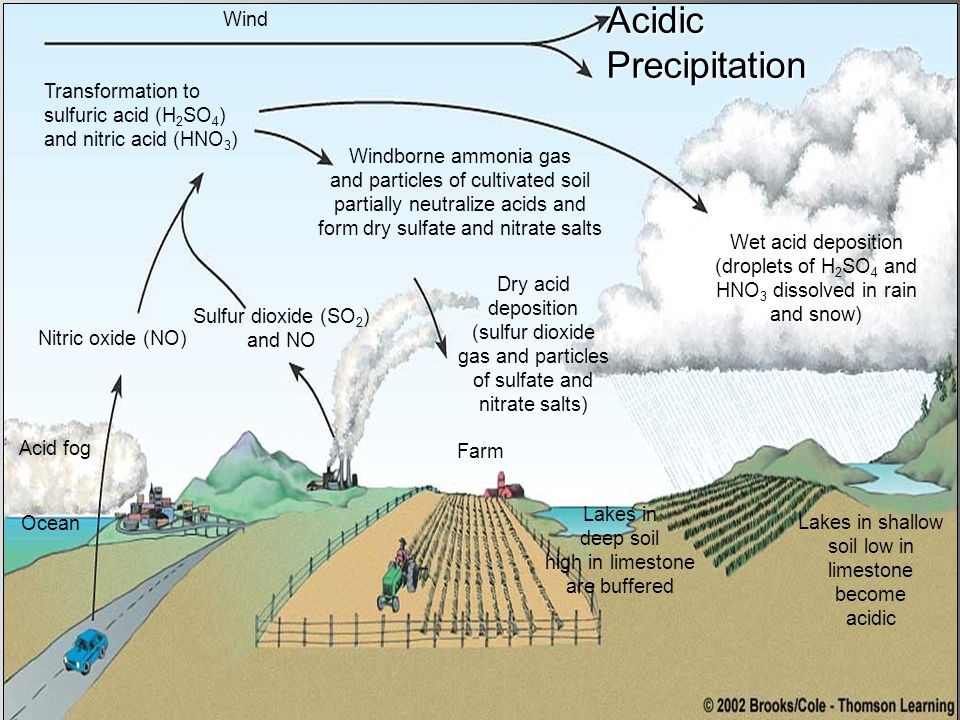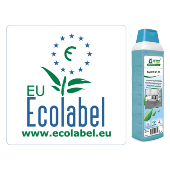Biodegradable waste includes any organic matter in waste which can be broken down into carbon dioxide, water, methane or simple organic molecules by micro-organisms and other living things by composting, aerobic digestion, anaerobic digestion or similar processes. In waste management, also includes some inorganic materials which can be decomposed by bacteria. Such materials include gypsum and its products such as plasterboard and other simple organic sulfates which can decompose to yield hydrogen sulphide in anaerobic landfill conditions.
In the domestic waste collection, the scope of biodegradable waste may be narrowed to include only those degradable wastes capable of being handled in the local waste handling facilities. Biodegradable waste when not handled properly can have an outsized impact on climate change, especially through methane emissions from anaerobic fermentation that produces landfill gas. Other approaches to reducing the impact include reducing the amount of waste produced, such as through reducing food waste.
Climate Change Impacts
Landfill
Landfill gas is a mix of different gases created by the action of microorganisms within a landfill as they decompose organic waste, including, for example, food waste and paper waste.
Landfill gases influence climate change. The major components are CO2 and methane, both of which are greenhouse gas. Methane in the atmosphere is a far more potent greenhouse gas, with each molecule having twenty-five times the effect of a molecule of carbon dioxide. Methane itself however accounts for less composition of the atmosphere than does carbon dioxide. Landfills are the third-largest source of methane in the world.
Because of the significant negative effects of these gases, regulatory regimes have been set up to monitor landfill gas, reduce the amount of biodegradable content in municipal waste, and create landfill gas utilization strategies, which include gas flaring or capture for electricity generation.
Landfill gases influence climate change. The major components are CO2 and methane, both of which are greenhouse gas. Methane in the atmosphere is a far more potent greenhouse gas, with each molecule having twenty-five times the effect of a molecule of carbon dioxide. Methane itself however accounts for less composition of the atmosphere than does carbon dioxide. Landfills are the third-largest source of methane in the world.
Food waste
Food loss and waste is a major part of the impact of agriculture on climate change and other environmental issues. Food production is resource-intensive, therefore food lost or wasted entails poor use of resources and will have negative environmental impacts. Reducing food loss and waste will improve resource use efficiency and lower greenhouse gas emissions per unit of food consumed because more food reaches the consumer for a given level of resources used. Moreover, food waste that is not handled or reclaimed properly, i.e., through composting, can have many negative environmental consequences. For example, landfill gas from anaerobic digestion of organic matter is a major source of the greenhouse gas methane, and un-reclaimed phosphorus in food waste leads to further phosphate mining. Moreover, reducing food waste in all parts of the food system is an important part of reducing the environmental impact of agriculture, by reducing the total amount of water, land and other resources needed to feed the global community.
The international community has identified reduction of food waste as an important part of developing a sustainable economy with Sustainable Development Goal Target 12.3 seeking to “Halve global per capita food waste at the retail and consumer levels and reduce food losses along production and supply chains, including post-harvest losses” by 2030″. Moreover, climate change mitigation strategies prominently feature reducing food waste; for example, Project Drawdown describes reducing food waste as one of the more effective ways to reduce the carbon intensity of the food system.
One-third of the world’s food is thrown away. According to the United Nations, the resources used to produce this squandered food are equivalent to 3.3 billion tons of CO2 emissions and three times the volume of Lake Geneva. Food waste happens mostly at the end of the food supply chain, at the point of consumption, in industrialized nations.
Biodegradable Waste Management
Human Health Effects
Burning trash in the open produces many pollutants, including:
- Dioxins
- Particle pollution
- Polycyclic aromatic hydrocarbons
- Volatile organic compounds
- Carbon monoxide
- Hexachlorobenzene
- Ash
Many dangerous health conditions can be caused by inhaling or ingesting even small amounts of these pollutants. Small children, the elderly, or people with preexisting respiratory conditions can be especially vulnerable to some of these pollutants.
Dioxins
Backyard burning is of particular health concern because it produces significant quantities of dioxins. Dioxins and “dioxin-like” compounds are a group of 30 highly toxic chlorinated organic chemicals. They are produced naturally in small quantities but are primarily the result of human activity. They can be produced through industrial processes such as chlorinated chemical manufacturing and metal smelting. Currently, however, the largest quantified source of dioxin emissions is the uncontrolled burning of household trash (backyard burning). Studies have shown that only small amounts of chlorinated materials in waste are required to support dioxin formation when burning waste. This means that even when materials containing high levels of chlorine, such as PVC, are removed from household trash, burning the waste still creates dioxins because nearly all household waste contains trace amounts of chlorine.
Much of the dioxins created and released into the air through backyard burning settle on plants. These plants are, in turn, eaten by meat and dairy animals, which store the dioxins in their fatty tissue. People are exposed to dioxins primarily by eating meat, fish, and dairy products, especially those high in fat. Backyard burning occurs most commonly in rural farming areas where dioxin emissions can more easily be deposited on animal feed crops and grazing lands. These dioxins then accumulate in the fats of dairy cows, beef, poultry, and swine, making human consumption of these harmful chemicals difficult to avoid.
Dioxins are classified as persistent, bio-accumulative, and toxic pollutants (PBTs). PBTs are highly toxic, long-lasting substances that can build up in the food chain to levels that are harmful to human and ecosystem health. Persistent means they remain in the environment for extended periods. Bio-accumulative means their concentration levels increase as they move up the food chain. As a consequence, animals at the top of the food chain (such as humans) tend to have the highest dioxin concentrations in their bodies.
Dioxins are potent toxicants with the potential to produce a broad spectrum of adverse effects in humans. Dioxins can alter the fundamental growth and development of cells in ways that have the potential to lead to many kinds of impacts. These include adverse effects upon reproduction and development, suppression of the immune system, disruption of hormonal systems, and cancer.
Particle Pollution
Particle pollution also referred to as particulate matter, or PM refers to microscopic particles released by open burning. Particles that are small enough to get into the lungs (those less than or equal to 10 ums in diameter) can cause numerous health problems. Particles can aggravate respiratory conditions such as asthma and bronchitis and have been associated with cardiac arrhythmia (heartbeat irregularities) and heart attacks. People with heart or lung disease, the elderly, and children are at the highest risk from exposure to particles.
Polycyclic Aromatic Hydrocarbons
Polycyclic aromatic hydrocarbons, or PAHs, are a group of chemicals commonly found in particulate matter (or smoke and soot) released from backyard burning. They are formed from the incomplete combustion of certain materials. Some PAHs are carcinogenic, or cancer-causing.
Volatile Organic Compounds
People near a burn barrel are also exposed to high levels of volatile organic compounds (VOCs) produced by open burning. Many VOCs are harmful to humans. They also contribute to ground-level ozone pollution, also known as smog, which can worsen respiratory, heart, and other existing health problems. Inhaling certain VOCs can lead to eye, nose, and throat irritation; headache; loss of coordination; nausea; and damage to the liver, kidney, and central nervous system.
Carbon Monoxide
Another major pollutant generated by backyard burning is carbon monoxide (CO). At low levels of exposure to CO, humans may experience a variety of neurological symptoms including headache, fatigue, nausea, and vomiting.
Hexachlorobenzene
Hexachlorobenzene, or HCB, is a highly persistent environmental toxin that degrades slowly in the air and, consequently, undergoes long-range atmospheric transport. HCB bio-accumulates in fish, marine animals, birds, lichens, and animals that feed on fish or lichens. Based on studies conducted on animals, long-term low-level exposures may damage a developing fetus, cause cancer, lead to kidney and liver damage, and cause fatigue and skin irritation. HCB is considered a probable human carcinogen and is toxic by all routes of exposure.
Ash
Backyard burning also produces ash residue, which can contain toxic metals such as mercury, lead, chromium, and arsenic. These metals can be toxic when ingested. When a person ingests hazardous amounts of lead, for example, he or she may experience high blood pressure, cardiovascular problems, kidney damage, and brain damage. Unaware of the potential danger, some people scatter the ash in their gardens or bury it on their property. Garden vegetables can absorb and accumulate these metals, which can make them dangerous to eat. Children playing in the yard or garden can incidentally ingest soil containing these metals. Also, rain can wash the ash into groundwater and surface water, contaminating drinking water and food.
Environmental Effects
Backyard burning produces various compounds toxic to the environment including nitrogen oxides, volatile organic compounds (VOCs), carbon monoxide, and particle pollution.
- Nitrogen oxides, or NOx, is a group of nitrogen compounds that are partially responsible for acid rain and contribute to global warming, ozone depletion and the formation of smog.
- Volatile organic compounds, or VOCs, are carbon-based compounds that undergo photochemical reactions (i.e., they react with sunlight) when released into the atmosphere. The VOCs and the compounds they form in the atmosphere, such as ozone, contribute to the formation of smog.
- Carbon monoxide, or CO, chemically reacts with sunlight to create harmful ozone. CO production can significantly impact ambient air quality and a region’s ability to meet Clean Air Act regulatory air quality standards. Burning garbage in a barrel or pile produces more CO than decomposition in a landfill. CO is also a significant greenhouse gas.
- Particle pollution, also known as particulate matter, or PM, refers to the fine particles that produce visible smoke that reduce visibility and creates haze, which is a major air pollution problem for many rural communities. In addition to being unhealthful, particles soil our homes and cars and transport dangerous chemicals, such as dioxins.
Any waste pollutes the air with toxins
Air pollution is the contamination of air by municipal garbage, smoke which creates toxic and harmful gases. They are 95% oxides of Carbon, nitrogen, and sulfur. The mismanagement of Landfill waste is caused by garbage pollution.
The effect of garbage pollution is the spread of harmful bacteria and viruses in the surroundings, as well as obnoxious odours which will also end up as air pollution. The water will also get contaminated which will transmit parasites, bacteria, and many sicknesses to humans and all sorts of animals. Garbage packed in plastic bags causes plastic pollution. Hard and soft non-biodegradable plastic that stays on the land for thousands of years or forever. There is no biodegradable plastic only a cheat. Pretty much all plastic is a type of carbon. It will stay forever in the soil, river, lakes, and oceans and harm the environment. Garbage is the major cause of indoor air pollution.
Municipal Garbage Impact
Toxic Air Pollutants
Pollutants produced by backyard burning of garbage are released primarily into the air, and close to ground level where they are easily inhaled- “With no pollution controls”. Garbage air emissions include Methane (CH4), carbon monoxide (CO), carbon dioxide (CO2), nitrogen oxides (NOx) and sulfur oxides (SOx)
Killing Air Pollutants
Big amounts of more poisonous chemicals are commonly detected in the garbage smoke and trash: Benzene, styrene, formaldehyde, polychlorinated dibenzodioxins (PCDD), Polychlorinated dibenzofurans (PCDF), Polychlorinated biphenyls (PCBs), and heavy metals such as lead, mercury, and arsenic.
Dioxins
Among the environmental and health risks posed by residential garbage, dioxin is the key concern. Dioxin is a potent human carcinogen that is especially harmful to adults, children and pregnant women. Dioxin is also an endocrine disrupter and can cause reproductive, developmental, and immunological problems in humans and animals.
Garbage Barrels – No. 1 source of dioxin in the world. Just one barrel can produce as much as dioxin to make a whole family sick.
Atmosphere Deodorant
PuraHub product reacts with organic molecules and transforms into hydroxyl radicals, also creates sufficient energy to breakdown hydrocarbons. Hydroxyl radicals (OH.) are composed of a hydrogen atom bonded to an oxygen atom. They are highly reactive, readily stealing hydrogen atoms from other molecules to form water (H2O). All pollutants and greenhouse gases, such as Methane and more complex hydrocarbons are initially broken down by the product radicals. This is the reason product is called Atmosphere’s Deodorant or Detergent. The earth’s atmosphere is capable of cleaning itself and of removing greenhouse gases (CO2).
Hydroxyl radicals are highly reactive molecules, convert these pollutants into water-soluble compounds that are then removed in the form of rain.
| Evaporation | H2O (aq) = H+ + OH– |
| Condensation | CO2 + OH– = HCO3 |
| Precipitation | H+ + HCO3 = H2CO3 |
The radicals are the “Detergents” of the atmosphere. A drastic increase in air pollution is because of Ozone (O3). On particularly sunny days, ground-level Ozone is formed from nitrogen oxides originating from garbage trash or garbage barrels and even burning of garbage.
This ozone decisively contributes to the formation of summer smog. But in contribution to the formation of ground-level ozone, Volatile-Organic Compounds (VOCs) play a key role. These substances, including acetone, methanol, or benzene are either released into the atmosphere by landfill garbage.
Residents in big cities are currently coping with dangerous levels of air pollution such as sulfur dioxide, nitrogen dioxide and VOCs and all these molecules contribute to serious health issues. Ozone is a big issue in cities with photochemical smog. Breathing only slightly increased concentration of ozone 60-120 parts per billion (ppm) results in a range of respiratory symptoms. Symptoms include decreased lung function, increased airway hyperactivity and pulmonary inflammation.
Garbage
Most of the big cities with major waste problems are because of dumping toxic waste around the city and thereby causing high rates of cancer, allergies, and birth defects. Although not as deadly risky as dumping tons of waste around the city borders, overflowing waste containers and garbage all over is still a great nuisance and risk to our health and environment. The whole city starts to smell toxic odours presents five outcomes of overflowing garbage bins, garbage around the city, villages, and commercial centres, and suggests how the most advanced Deodor technology could ease the problems before getting seriously ill.
Bacteria, insects, and a huge number of small filthy animals (VERMIN) thrive from the garbage.
Overflowing waste bins and garbage all over the residential areas are an ideal breeding ground for bacteria, insects, and vermin. The flies that visit the garbage are also the same flies that roam around your lunch buffet and drop their offspring on your plate. By doing so, they increase your risk of contracting salmonella, which causes typhoid fever, food poisoning, enteric fever, gastroenteritis, and other major illnesses. Besides flies, other animals that thrive from the garbage in and around the containers include rats, foxes, and stray dogs.
24 hour’s later, as the world gets hotter and more crowded, our garbage starts to decompose, it pumps out awfully bad odours. The health effects of bad odours are really serious, one-third of deaths from stroke, cancer, and heart disease are due to Ozone as a major factor in causing asthma and keep making it worse, and nitrogen dioxide, sulfur dioxide could cause bad bronchial symptoms, lungs inflammation and reduce lung’s function.
Since Millions of years, the Earth could handle all these problems, but very sadly now the earth has lost its ability to remove air pollutants, bad odours the reason for a very fast spreading of smog and acceleration and accumulation of greenhouse gases. And the reason Three-Decade-Long worldwide decline of a key molecule that cleanses the air and atmosphere. Without enough of the molecules, emissions that contribute to the greenhouse effect, smog, and the hole in the Ozone layer do not get destroyed as fast as humans made garbage release’s them. Only-One-Molecule is very, very important that is marketed by PuraHub Limited.
Very Important
It is the most important chemical for the atmosphere Hydroxyl Radical “If this free-radical [Molecule] is decreasing, it could add to extreme global warming”.
PuraHub Catalyzed Oxygen:
- Promotes rapid oxidation of a wide range of all organic’s contaminants.
- Contains a built-in Purahub catalyst that remains active through the entire lifespan of the Hydroxyl-Radicals oxidation reaction.
- The proprietary and protected by a registered trademark the catalyst also eliminate the need for any other alternative treatment which is potentially hazardous activation chemistries.
- Single premixed 3 component product results in simplified logistics and application.
- No health and safety concerns than with the use of traditional activation methods such as Chlorine, Chlorates, Chelated metals, and Quaternary ammonium
- Zero residuals. Nothing is left behind after use. Does not need any rinse of treated garbage or area of garbage storage
- Killing efficiency against bacteria, viruses and fungi will be 5-Log 99.999%. Not toxic to humans and animals.
The invention of the product is to treat emission gases from residential, commercial, industrial waste, and garbage wherein these wastes produce bad odours, volatile organic compounds (VOCs) contaminants, and numerous hydrocarbon compounds. All the gases from wastes are considered pollutants and need to be treated and removed from the garbage before the release of the gas and odours to the atmosphere. The removal with PuraHub product includes Hydroxyl-Radical generation technology.
Odours compounds, which could be organics, and inorganics can fill the air in and around the residential neighbourhood. Such odours and VOCs can range from mildly offensive to intolerable levels. This is a worldwide problem in cities with more than 10, 000 residents. Examples of odorous sources include industries that process organic materials such as those that process and produce food for human consumption and industries that produce animal feed for the pet, fish, poultry and hog industry and general agricultural applications. Other organic odour sources include composting facilities, MBT plants, sewerage treatment centres, garbage transfer stations, landfill stations, contaminated lakes, ponds, rivers.
PuraHub Limited product technology has been used to create the oxidation that generates the activated species required for the purposes to destroy toxic gases using Reactive Oxygen Species (ROS) including Hydroxyl Radicals. For the activated species generated in the oxidation process, these ROS species here have the highest reduction potential (between about 3.5 and 6.4 eV) have the shortest availability with half-life concentrations of less than about 100 milliseconds. These react with toxic odours molecules that need a high reduction potential oxidizer for decomposition.
| ONE | DE O2 → For → Dioxygen |
| TWO | D O2 R → For → Cation Dioxygen |
| THREE | O2 XY → For → Anion Superoxide |
| FOUR | PER O2 XIDE → For → Anion Superoxide |
“Common” oxygen in air O2 is in the ground is a free “Diradical” having two unpaired electrons. Ordinary Oxygen does not react well with most molecules, but it can be “activated” by the addition of energy expressed as O2 O2 O2 and O2 with a strong catalyst with photochemical energy and transformed into reactive oxygen species (ROS). The transformation of oxygen into a reactive state from the addition of a single electron is called reduction. The donor molecule that gave up the electron is oxidized
O2 + e → O2 .-
The result of the monovalent reduction of triplet oxygen is superoxide O2 .- it is both a radical and an anion (charge of -1). Other reactive oxygen species known to be created with the product are shown below
| 2O2 – + H + → H2O2 + O2 · |
| O2 – + H2O2 → O2 + OH + OH – |
| O2 – + H2O → O2 + HO2 – + OH – |
| 2O2 – + H2O → 2O2 + OH – + OH |
PuraHub Product Technology
- Fast and complete reaction with toxic contaminants
- Treat the complete range of waste
- Does not leave toxic or undesired residual by-products
- Most cost-effective, easy to apply
- So safe, contaminant breaks down to CO2 + H2O
- When mixed with water product forms a solution that can be mixed with any waste, sludge, landfill, garbage or injected on the surface.
Removal of Odours and Toxic Air Pollutants
Air pollution is the contamination of air by municipal garbage, smoke which creates toxic and harmful gases. The effect of garbage pollution is the spread of harmful bacteria and viruses in the surroundings, as well as obnoxious odours which will also end as air pollution. Garbage air emissions include Methane (CH4), Carbon monoxide (CO), Carbon dioxide (CO2), Nitrogen oxide (NOx) and sulfur oxides (SOx).
PuraHub Limited has marketed a versatile Atmospheric Deodorant for solving odour problems in various applications with self-cleaning ability. The invention of the product is to treat emission gases from residential, commercial, industrial waste. And garbage wherein these wastes produce bad-odours, volatile organic compounds (VOCs) contaminations. It destroys all possible odours as well as sanitize, clean, and reduce contaminants that are damaging the health of humans, animals, and plants.
The PuraHub Product reacts with organic molecules, transforms into hydroxyl radicals, and creates sufficient energy to break down hydrocarbons. The product with its production into hydroxyl radicals is the only product that breaks down air pollution.
















